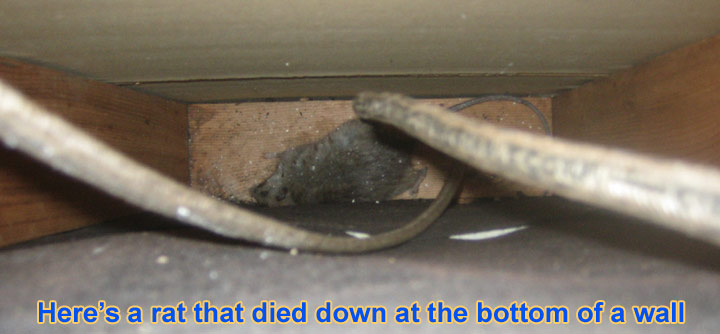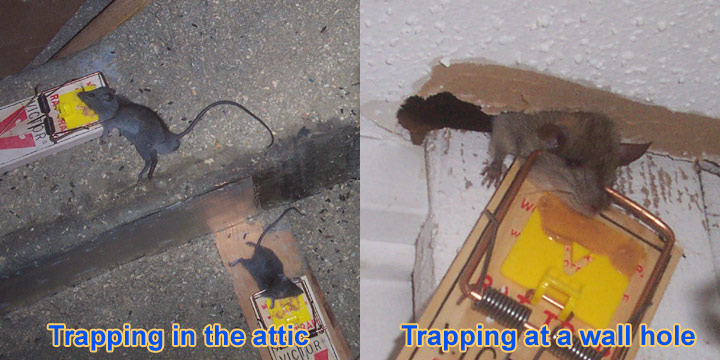-
info@aaanimalcontrol.com
Call us for help in your town
Humane Wildlife Education
Rats in the Wall - How to Get Rats Out of Your Walls
Need rat removal in your hometown? Click here to call us for a free price quote for rat removal - we service over 500 USA cities/towns as of 2020. Or follow the below 4-step process exactly to do it yourself.
After you read the below information, you may want to click on one of these guides that I wrote:
How much does rat removal cost? - get the lowdown on our prices.
How to get rid of rats - my main DIY rat removal info guide.
Do you hear scratching in your walls? Perhaps the pitter-patter of little feet scurrying up and down the walls of your home? If you hear this scratching and running noise at night,
it's most likely rats in the walls. The below guide helps explain the problem, and offers solutions to several scenarios dealing with these rodents in the wall.
How Did They Get Inside My Wall? Rats love to live inside homes. Most are born inside houses, often in the attic or walls. But first, they come from outside, and find a way into the house. They can use dozens of possible entry points
into the house, from unscreened vents on the roof, gaps at the eaves and roof edges, and areas at ground level, such as open A/C chases or gaps under the siding or in the outer walls. If they enter at ground level, they usually run up the
walls of the home and go into the attic. The rats usually spend most of their time inside in the attic. But sometimes they set up shop, and create nests, inside the walls of homes.
Once in an attic, they can easily find their way down the walls of homes as they search out new areas and seek a way to get into the house, if they detect food.

I took the above photograph from inside the attic of a home. I lowered my arm and camera down the wall to get this shot. In this case, a curious rat fell down a wall from the attic. There was nothing to hold on to - no wires or pipes, and the sides of the wall were slick, so the rat got stuck.
This happens often, and then the homeowner hears noises in the wall, a lot of frantic scratching inside the wall, as the rat struggles to climb out, but can't. In this case, if the rat isn't removed, it will die, and create a big stinky odor as it rots.
In a case like this, I can grab the rat with a grasping device and remove it.
What do they do once inside the house or walls? The just use the area as a safe place to live. And while they're at it, they chew on wood, chew on electrical wires (a potential fire hazard), they poop and pee everywhere (which is not only unsanitary, but
the odor attracts new rats to the area), and they often chew their way into the house to find their way to the kitchen or other food sources. They also spread disease. They reproduce quickly, and will create rat nests in the wall or in the attic.
I've cut open walls at several homes and found rat nests inside, with many baby rats.

Here's a photo of a dead rat down a wall. This rat obviously had easy ways to climb up and down the wall, with the wires, but it just naturally expired and died down this wall. I was able to reach down this wall with a special grasping pole and remove
the rat without cutting any holes in the wall from inside the house.

Most of the time, the wall is not accessible from the attic. It's either closed off in some way (but with space for rats to get in), or it's at the edge of the house, where there's no room for a person to crawl and look down. In such cases, I have to
sniff out the location of the dead rat in the wall, and cut a hole, and remove the rat. It's not an easy task. In the photo to the left, the rat died on top of a beam midway through the wall, and actually behind an antique portrait! The photo to the
right is more common, a dead rat at the bottom of the wall, near the baseboards.
So how do I solve the problem then? Well, first and foremost, you've got to stop the source of the rats! They are finding their way into your home or building somewhere, right? You must
inspect EVERY SQUARE INCH of the house, and find every possible rat
entry point. That includes the plumbing pipes at times! Learn about: How do animals get inside a house? It's really honestly a field best left to experts. Without extensive knowledge of house architecture and rat behavior, you're not going to find all the entry points. And if you don't, then forget it, you'll
never solve the problem. All the areas that are sealed shut should be sealed shut with steel, which rats, as rodents, won't be able to chew their way through. Once all the areas are sealed, you've got to trap and remove all the remaining rats, as seen below. I
outline the process in my how to get rats out of the attic guide.
The 4-Step guide for getting rats out of the walls:
- Step 1 - Inspect the entire exterior of the house or building, and find any and all entry holes, as small as 1/2 inch.
- Step 2 - As you find these areas, seal them shut with steel mesh, which rats cannot chew through.
- Step 3 - Only after the home is entirely sealed shut, go into the attic space and set wooden snap traps. Location is crucial: the rats are running up and down your walls and into the attic. Find these places and set the traps there.
- Step 4 - Every day, remove trapped rat bodies, and re-set traps. In just 2 or 3 days, all will be caught.
- SUCCESS - Once you hear no more scurrying noises in the ceiling or walls, you know you've done it! FAILURE - If you still have rats, it means you failed steps 1 & 2. You must find the remaining holes.
- WHAT IF A RAT IS STUCK? - Rats in walls usually have no problem crawling up and down the wall, via pipes or wires. But if a rat is truly STUCK, you must get it at the opening at the top of the wall, or cut a hole in the drywall at the bottom.

That's the basics of how to get rid of rats in the walls. The best way to solve a problem with rats in walls is to eliminate their access points into the building, and then trap and remove them, and the easiest place to do that is in the attic, where they spend most of their time inside. It's impossible to set traps down walls, where it's inaccessible, and there's no room.
However, in some cases, such as with the photo to the right, there's a hole leading into the wall void, in which case I can mount a trap on the wall near the hole, and catch the rat right at the hole as it tries to come out.
The traps are more successful when placed on the primary rat runways. Although the rats run up and down the wall, set the traps in the attic on the rat paths. This will catch all remaining rats once the home is sealed. If the home is not properly sealed,
the problem with rats in my wall won't ever be solved.
 Click for my rat removal photo gallery.
Click for my rat removal photo gallery.
Over 60 photographs of actual rat removal jobs I've done.
 Visit my awesome rat trapping blog!
Visit my awesome rat trapping blog!
Over 25 examples of specific rat control jobs I've done. Get ideas!
For more rat removal articles, click any of the below:
rat poison
mouse in the attic
rat extermination
how to kill rats
rodent trapping
rodents in the attic
Rodent removal
how to get rid of rats
And if you need to know how to get rid of rats in the walls, dead rats that is, click on dead rodent in a wall.
If you don't know what type of animal you have living in the walls, then it could be squirrel, opossum, raccoon, mouse, or even cat. Only an inspection, or cutting open the wall or drilling a peep hole in which you can insert a
fiber optic inspection scope, will tell you what type of animal is in there. But if it's a light scurrying sound at night, going up and down the drywall, then it's almost certainly rat or
mouse.


















